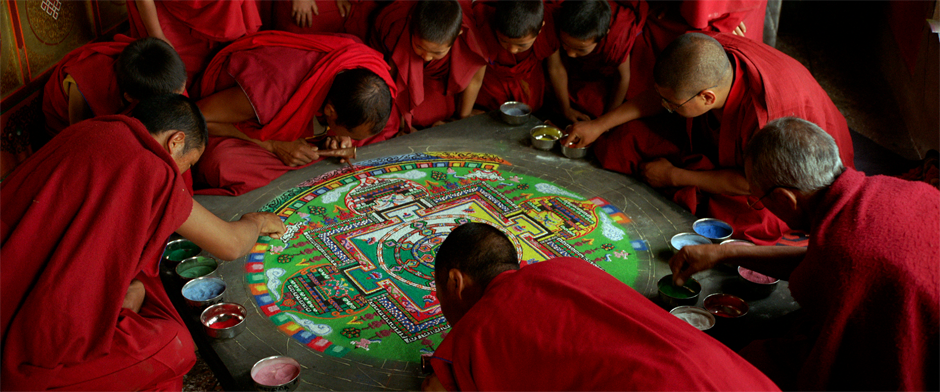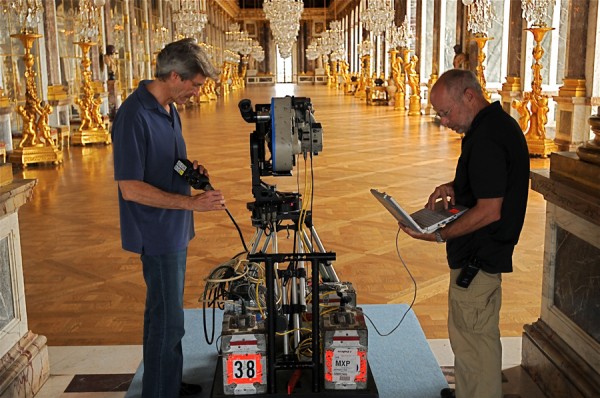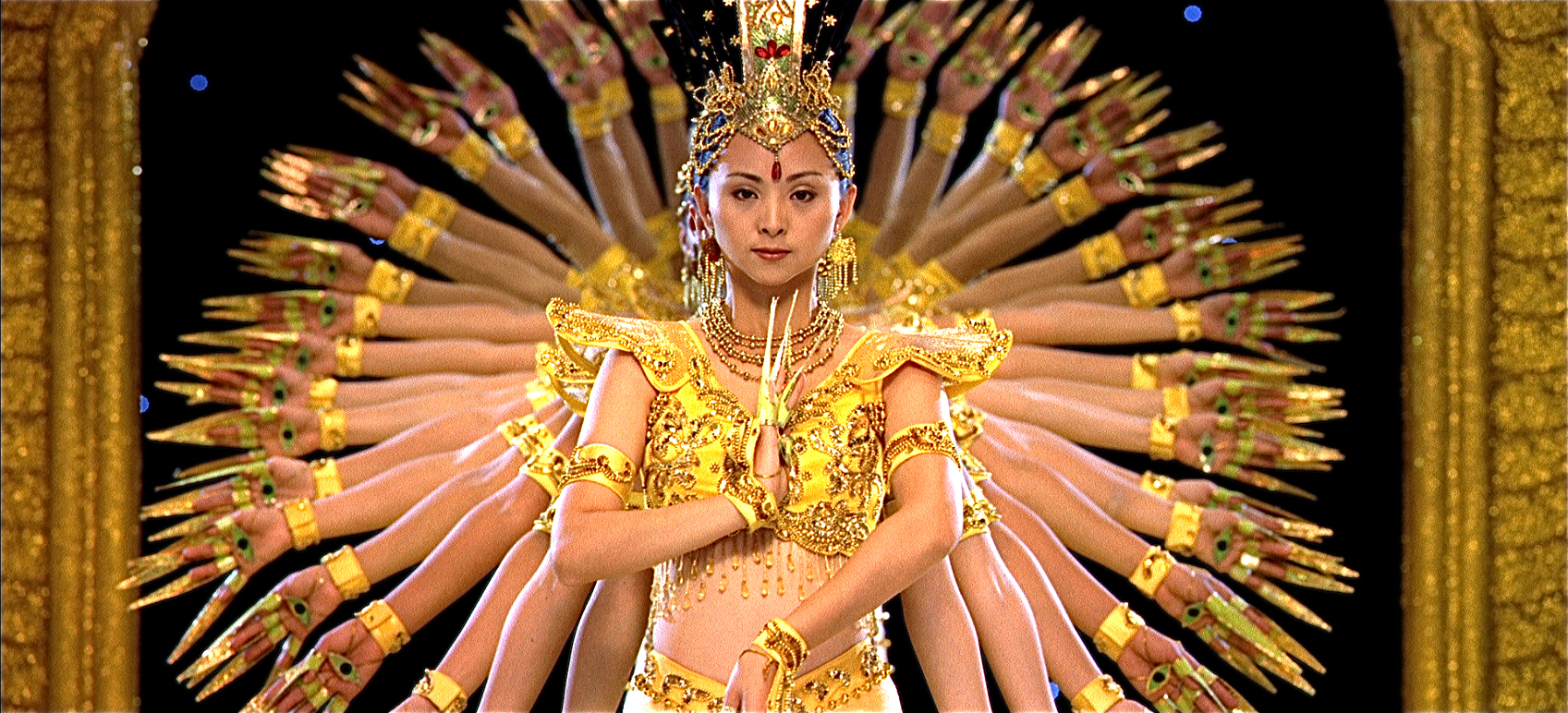[tabs tab1=”Concept” tab2=”Production” tab3=”Construction” count=”3″]
[tab_first]
Producer Mark Magidson and director/cinematographer Ron Fricke, have established an international reputation for making visually stunning films that investigate the human condition in epic, dialogue-free documentaries. Their previous film BARAKA became a worldwide hit, and their latest film SAMSARA looks like doing the same. We spoke to the pair about the ideas behind their film and the technical aspects of shooting on a large format film in the age of digital miniaturisation.
How do you go about starting a film like this? You clearly don’t just grab a camera and your passport and see what happens. Did you start off with a script?
MARK: Scripted is a little strong. It’s conceived. Samsara is a word that means birth, death and rebirth, or impermanence, so that’s the kind of imagery that directs the research, and the concept directs the research towards the imagery and locations. So that’s how you start. We had a structural element, which was the construction of the sand mandala, which we filmed in Ladakh, and that was the structural anchor, which ties it in with the themes of impermanence. Once we had that, we were feeling pretty good about filling in the rest of it.

For a documentary, it’s quite a luxury to know your beginning and end.
RON: Yeah. That was really great. The next project will be a good way to get that in place. That was a good lesson.
How did you make the decision on what to fill up the middle section with, because there is a massive variety of images from the sublime to the almost ridiculous.
MARK: You are looking for a big range. You are looking imagery that is highly visible, using the experience that we have, saying that’s something we’d really like to film, or not, as it doesn’t quite make it as it is not interesting enough. Those are the decisions you make. You pick the locations that are going to yield a number of that kind material, then try and access it.
RON: We made sure the locations are going to yield a lot of data and imagery for us before we dragged all that gear there. As Mark said, once we had that opening and closing, because the hardest part of making a film are how to open and close it, but once we had that… we’ve got the film, then we just had to follow the thread of the concept. When we got to certain locations, if things didn’t work out, there were other things. There were a lot of happy accidents on location where we found subjects that were just as good, or better. However, we did do a lot of research to move around the world. It wasn’t like we just packed up and said, let’s go.
MARK: It’s just too expensive to bring the equipment and crew anywhere. You’ve just got to pick your targets real carefully. We are also a relatively manageable size. We had four or five on the crew, depending on the trips. We did make some decisions on location that were quick decisions that were ambitious.
Does that come from the experience of your previous films?
MARK: It comes from feeling strongly enough about a subject. One example that comes to mind: we were in Ethiopia, in Addis Ababa, and we happened to be in the hotel book store, of all places, and we found this book on the tribes of the Omo Valley, that region in the southern part of Ethopia, just on the border with Kenya. It was a spectacular photographic journal, a really thick book, filled with amazing imagery of portraits of these various tribes. We wondered how we could get down there because it wasn’t very far. So we just changed our schedule and made it a priority. We were able to get down there pretty fast, and brought the crew down, and got all those portraits of people with the face paint and Kalashnikov rifles, which was all from there.
You said previously that you got a lot of ideas from YouTube.
RON: Yeah, from the Internet.
MARK: It’s absolutely true. It’s an amazing resource for research. It seems like everything is posted on there. The thousand hands performance, which is so iconic to the film and closes the film, and there is a little snippet of her at the beginning; it’s another structural element, along with the sand paintings. One of Ron’s friends found that on YouTube.
RON: My neighbour came over and knocked on my door and said, “You’ve got to see this.”
MARK: [Olivier de] Sagazan, the guy who puts the clay on his face, was another one we found on YouTube. The Filipino prison dance…
Kevin Macdonald’s LIFE IN A DAY film explores similar ideas to your film, but actually getting all the footage off YouTube.
MARK: Right. It’s about interconnection around the world.
How difficult is it getting access and permission to film, given some of the places you shot?
MARK: There are two aspects. Getting access to the locations is difficult. It’s a process that you have to take it one step at a time and just try to knock down barriers. More often than not we were successful, and a few times not. It’s really identifying material within the frenetic structure that is of a certain visual level.
Was there anywhere specific you couldn’t get into?
MARK: The one that got away was North Korea. We almost got in there to film these performances they do every summer, where people are dressed up like Busby Berkeley dancers. We got really close but couldn’t get over the hump. Pretty much everywhere else we could access.
[next][/tab_first]
[tab]
The film is almost like one of those big coffee-table books. The images have a lot of movement in them, but they are very still at the same time.
RON: The portraits in particular are based on still photography. These great still photographers like Karsh and Irving Penn get the essence right out, looking into the eyes of their subjects. It was a theme with Tut: he was staring at you from eternity, the connection there, between us all. The landscapes and the portraiture are based in working with a 65mm camera, as well, as it gets the essence of the location for you. There is a bit of it being, as you say, still. We tried to move the camera as much as we could. The idea of the whole film was the flow and interconnection of things.

There’s a lot of time-lapse shots with camera movement in the film. How did you achieve that with such large cameras?
RON: We had a MoCo system that we’ve been using over the years and created the software that gave us a pan, a tilt, a dolly and a lift. We’ve got it down so we can set it up really quick and programme it with all the short cuts built into it. It has a preview system. You give it the heads and the tails, how many seconds you want on the screen then watch it at 24[fps] as it moves the camera, then you shape it, turn it on and go away.
MARK: To shoot star fields, you’ve got to run it all night to get a ten-second take, whereas some of the other shots you can accomplish in 40 minutes.
RON: We’ve become pretty good at it now, so we know what’s going to work.
Was shooting on 65mm film always your first choice, or did you look at other options such as IMAX, 3D or digital?
MARK: We looked at digital, at the 2K digital standard in 2007 and felt it wasn’t ready, and felt that it would be outdated, as digital always inevitably is, in short order. We’d done three other films in 65mm, and said this is our only real option as it’s still the best way to do this.
How much gear did you have to take with you when you travelled?
MARK: It depended on the trip, and we had different types of stock and different film speeds, but we took enough of each. That’s one of the headaches of shooting on film now, the borders and the X-ray issues that you’re worried about. You don’t want to take more than you need because it’s a hassle to get to get it out, and you don’t want to run out either. You have that experience, and once in awhile we had to get some extra shipped in if we had a really great location but most of the time we were right.
Did you also think about shooting on film because it will last? Your movie is a record of contemporary humanity, and film will last at least 100 years, whereas digital — one EMP and it’s gone.
MARK: It feels really good to have our imagery recorded on 65mm negative. That’s a good feeling when you collect that imagery in the field and get it back home. It feels very solid.
[previous] [next][/tab]
[tab]
For the editing you digitally scanned all the film?
MARK: We did a telecine at very high quality for editing, which is a really nice way to edit. It was actually good enough that we could project it on a decent size screen and see it, without going through the scanning, the process we did later to output the film to the final version that is showing, which is a whole different, much higher tech, more expensive process than the telecine. It was scanned at 8K.
There aren’t any digital cameras that come close to that at the moment.
RON: Not yet, but give it a year.
MARK: There’s tremendous resolution in the film stock and it ends up in the digital file when you scan it at 8K. The file for the film was 20Tb, so there was a lot of detail in there.
There is also a lot of latitude that you get with film that digital is only just starting to match.
RON: And there is just detail in the 65mm neg that gets into the concept of the film and brings out the essence of these landscapes and portraits. There’s such a level of latitude, if you really know what that means, that reaches into the highlights and shadow detail. You’re always feeling safe and grounded. You know what this emulsion is going to do. You kind of walk around like this film emulsion. After being on the road for three years, doing it, we just turn into these mean, lean, photographic machines. It was just a short cut. You’d just look at the location and you’d know where to put that camera, what to shoot and what not to shoot. You were just after the essence of the place and not shooting a whole documentary about the place. It was about putting that together in a flow – a global flow.
Can we talk about how you approached the editing and scoring of the music?
MARK: The editing was done silently. We had that imagery. We had that structure and that structural component, and you are really making the film with the reality of the imagery, which has an essence. It’s non-fiction and has an essence and energy within it, and you have to become very familiar with everything you’ve got, to make the film with. How to structure it and put it together, how the imagery wants to flow together and connect, and find those really cool connections that you couldn’t have written, where the imagery links up, or says something, or takes you through transitions that are really powerful and meaningful. That’s an exciting part of the process. You’re back from all the travel, you’re in a controlled environment. It’s a really nice place to be.
Most editors like to work to a rhythm when cutting; did you set up a rhythm that would help the composers?
MARK: It’s the cutting rhythm, the composers had to come in and compose to the sequences – the three, four or five minute sequences. There’s all this technology in music, and they’ve got a four minute sequence of images, and they lay that on in ProTools, their music software, and they can see the length the music’s got to be and they’re composing music to that length. You then end up with a really nice piece of music that’s not edited to every cut in the film, it’s just a real piece of music. That’s a nice way to deal, where there’s also some space in there, where you don’t have a rhythm exactly to the edit. It just works as a piece of music. It works independently and comments on the edit. It allows the viewer to experience it with a little more space.
SAMSARA isin cinemas now.
[previous][/tab]
[/tabs]


